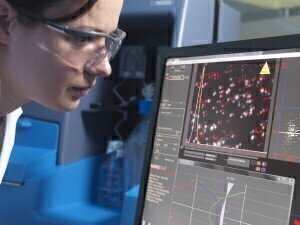-
 NanoChOp project highlights the value of Malvern Instruments’ NanoSight NTA system for unique insight into the behavior of nanoparticles in biological systems
NanoChOp project highlights the value of Malvern Instruments’ NanoSight NTA system for unique insight into the behavior of nanoparticles in biological systems
News & Views
NanoChOp project highlights value of NanoSight for monitoring nanoparticle characteristics in biological systems
Mar 29 2016
Researchers working on the European Metrology Research Project NanoChOp (Chemical and Optical Characterization of Nanomaterials in Biological Systems), funded by EURAMET, have concluded that the NanoSight Nanoparticle Tracking Analysis system from Malvern Instruments offers unique insight into the behavior of nanoparticles in biological systems. Such insight supports ongoing efforts to assess the potential risks to human health posed by the increasing use of nanomaterials.
Dorota Bartczak, Researcher in Inorganic Analysis at LGC commented that ”Measurement methods and techniques that provide reliable data for researchers to understand how nanoparticles behave in complex biological systems are crucial for the human risks assessments needed to ensure that the increasing use of nanomaterials does not endanger public health. The NanoSight system measures nanoparticle size, concentration and surface charge simply and quickly. Recent software upgrades have enhanced its capabilities and we can now successfully study individual nanoparticle populations at the high serum concentrations that reflect conditions in nanotoxicology models.”
LGC is a global leader in the laboratory services, measurement standards, reference materials, genomics and proficiency testing marketplace and is the national measurement laboratory with designated responsibility for chemical and bio-metrology. LGC coordinated the consortium of laboratories and academic institutions that completed the EU NanoChOp project. The project’s underlying aim was to develop a series of metrologically validated characterization methods to support the commercial exploitation of nanomaterials and to produce candidate reference materials that could be used for quality control of the measurements. Such measurement strategies will be invaluable for future human risk assessments and in the longer term, to ensure human health.
“NanoSight uses Nanoparticle Tracking Analysis to measure number-based particle size distribution and concentration measurements, so it is clear exactly how many particles of any specific size are present,” said Dr. Bartczak. “Number-based measurements are critical to meet EU regulations relating to the testing of foods and cosmetics, but they also enable the direct study of critical processes such as agglomeration. With NanoSight we can see an increasing population of larger particles and a simultaneous reduction in particle concentration as agglomeration occurs. Such analysis makes it easier to reliably assess the characteristics of these complex nanoparticle systems.”
To find out more about the NanoChOp project,
To find out more about the NanoSight range
Malvern, Malvern Instruments and NanoSight are registered trademarks of Malvern Instruments Ltd
Digital Edition
ILM 49.5 July
July 2024
Chromatography Articles - Understanding PFAS: Analysis and Implications Mass Spectrometry & Spectroscopy Articles - MS detection of Alzheimer’s blood-based biomarkers LIMS - Essent...
View all digital editions
Events
Jul 28 2024 San Diego, CA USA
Jul 30 2024 Jakarta, Indonesia
Jul 31 2024 Chengdu, China
ACS National Meeting - Fall 2024
Aug 18 2024 Denver, CO, USA
Aug 25 2024 Copenhagen, Denmark

.jpg)

24_06.jpg)













